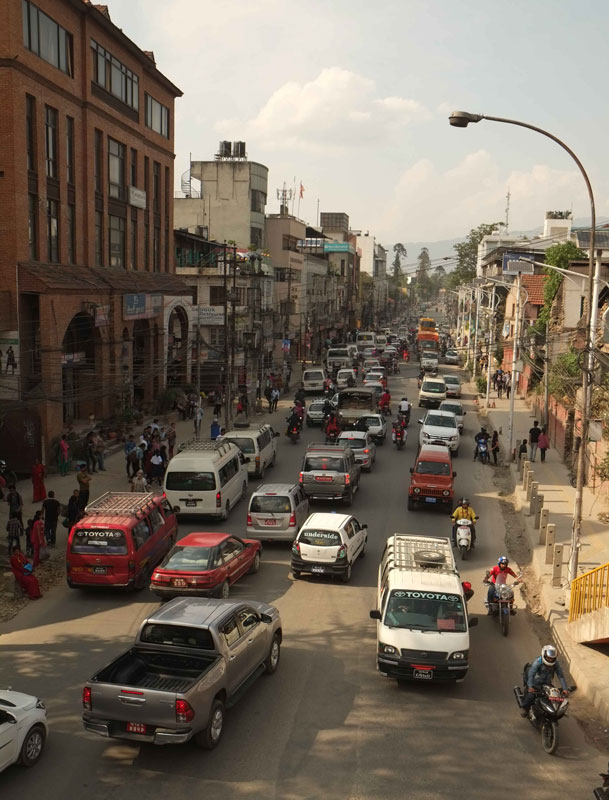Urban Health in Kathmandu
Kathmandu is one of the fastest-growing urban centres of the world – its population growth at an annual rate of around 4 %; in 1950, the city had a population of a little over 100,000 people, today, it is an estimated 2 million, with growth accelerating over the past 15-20 years. The greater Kathmandu Valley region today has an estimated 3 million inhabitants.
This growth mostly happened in without regulation; efforts for a more planned growth have only started in recent years with important projects, for example the Melamchi water project addressing the chronic shortness of water and the problem of water quality. The city suffers from traffic problems and air pollution, public transport provision is insufficient and is limited to minibuses and buses; they are supplemented by a multitude of private service providers.
Health care for the population is – like in Nepal in general – theoretically ensured by government services; in practice, many of these institutions suffer from absenteeism, inadequate facilities and equipment, and a lack of medication and other supplies. What is more, one Urban Health Clinic theoretically serves a population of more than 60,000 people (in Kathmandu, there are 33 such clinics for a population of ca. 2 million people), which means that healthcare would be insufficient even if all clinics were fully functional. Those who can afford it therefore use private health care (pharmacies, hospitals). This means that the poorest fall by the wayside, as those with political or social influence have no real interest in improving government primary health care. The numbers are clear: the risk of children from the poorest quintile of the urban population dying before the age of 5 is 4.5 times higher than of those in the richest quintile; equally, only 45 % of the women from the poorest quintile have access to qualified obstetric assistance (compared to 85 % of women from the richest quintile). In addition, illness increases the risk of poverty in poorer populations, even “simple” illnesses like the flu or a fever.

Urban Poverty in Kathmandu
Since the civil war years from 1996 to 2005, Kathmandu has seen an increased influx of people from rural areas (Internally Displaced People/ IDPs or migrants moving to the city because of political insecurity or the loss of income sources), who have neither financial resources nor an education and therefore mainly work in the informal sector and live in informal settlements or slums, in particular along the Bagmati river and its tributaries, which are all highly polluted. These informal settlements are not recognized by the authorities and therefore do not get infrastructure (drinking water, power, sewage, waste removal, …), and are even periodically evacuated and destroyed.
Urban poverty has been on the rise in Kathmandu in the past years, while rents and prices have increased more than average over the same period. Many urban poor are illiterate and unskilled; in 2011, roughly 60 % of the Kathmandu poor were migrants from rural regions of Nepal. A study our partner organization PHASE Nepal has recently conducted in preparation for a project to improve healthcare for informal waste workers in the greater Kathmandu region showed an illiteracy rate of 50 %; surprisingly, 48 % of the respondents came from India; whether this high illiteracy rate is typical of the highly stigmatized work of waste removal, or may be found in other urban poor, too, will be ascertained in a baseline study. The slums and poor settlements are not focused in one or a few places, but are scattered in larger or smaller zones with a wide variety of population sizes – from very small settlements of less than 10 to larger conglomerates of more than 300 households.
A recent study amongst urban poor in Kathmandu found that mainly women are often affected by undernourishment, as traditionally, they are the last to eat in the families. The daily wages of unskilled female workers is still about a third less than that of men.
The prevalence of informal and “self-employed” forms of livelihood – services, waste collection and sorting, street vending, employment as domestic help, begging etc. – means that illness and disability carry an enormous risk of debt and loss of income. In some households, the children are the only breadwinners, in particular when parents are elderly or have chronic health issues. Health risks are particularly high among the urban poor: poor living conditions and hygiene, a lack of food security, poor water quality and a lack of sanitation (toilets, sewage, waste removal …); in addition, many of the slum settlements lie in the immediate neighbourhood of landfill sites and waste sorting centres, or along the heavily polluted rivers.
Among the inhabitants of these informal settlements, we can still distinguish different social levels – the poorest (ca. 37 %) have no income security at all, or an income that neither provides them with food security nor enables them to buy the most basic necessities; others (ca. 26 %) have an income which gives them food security, but is not sufficient to buy clothes or pay rent, or who regularly need to incur debts due to their irregular incomes. There is also a stratum of the “less poor” (ca. 36 %), who have a regular income and tend to have skilled employment, are able to save some money, and to buy things like a motorbike, a television set or a fridge, or pay for power, but still are in the precarious situation of living in an informal settlement. The poorest are concentrated near or in the centre, while the relatively better-off poor usually live in the periphery of Kathmandu.

